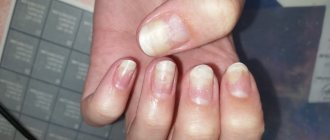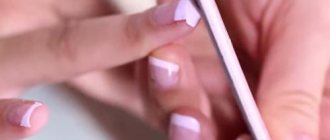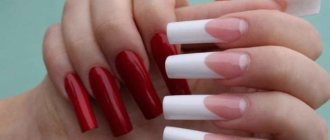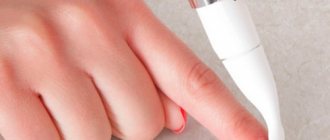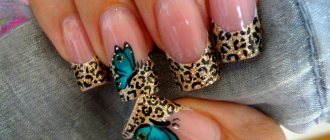Covering nails with gel polish requires the presence of a large number of devices and tools. Technologies for nail extensions, nail modeling, and decorative design creation involve a number of important stages that cannot be neglected. One of the stages is preparing the plate for applying a varnish base. But what to do if there is no product, but the manicure has already begun? How to replace nail degreaser at home, how safe and effective it is, is described below.
What is nail degreaser
The procedure for strengthening the nail plate, the process of extension with gel, acrylic is not complete without the most important step - cleaning the surface of the nail from contaminants. By pollution we mean not only dust particles, but also a physiologically determined fatty film that adds shine.
A degreaser is a product that removes any type of foreign particles from the nail plate: dust particles, sweat, fat layer. Today, such a product is produced on an industrial scale; if necessary, it can be replaced with a natural or synthetic analogue. Sometimes on the shelves of specialized stores you find a product that combines 2 functions: a degreaser and a product for removing the sticky layer.
Analogue version of the clinser – dehydrator
Having dealt with the question of what a clinser is, let's take a closer look at its most common analogue - a nail dehydrator. Undoubtedly, many have heard about it, and perhaps this is what you use to degrease the nail plate and remove the dispersion layer. Perhaps someone will even decide that these are again different names for the same product. And someone, reading the previous section, will decide that they are missing an important point in manicure by using a dehydrator and forgetting about the cleanser.
Both are wrong. Yes, a dehydrator and a cleanser have similar functions, properties and purposes, but they are completely different means. Thus, the cleanser acts more gently and removes only the natural fat layer from the nail plate. A dehydrator, in addition to removing the fat layer, removes excess water from the nail plate, penetrating deep into the nail. Thus, the dehydrator provides more reliable adhesion to the nail plate.
Interesting
Despite the fact that the dehydrator dries out the nail plate, it is the most gentle product among the group of degreasers. Its main active ingredient, butyl acetate, evaporates very quickly. After using the dehydrator, the pH balance is restored in the shortest possible time. In addition, once it gets on the skin, it does not cause irritation or allergic reactions.
Naturally, everyone must decide for themselves which product they will use to prepare their nails for applying gel polish. You just need to indicate in what cases it would be more appropriate to use one or another degreasing solution.
- If you have “wet” nails, then a dehydrator is your option. How to determine the “wetness” of nails? Only by experience. You may have noticed that you or your friends' manicures, done according to all the rules, begin to come off after just a couple of days, while for others it lasts for weeks. And so time after time. All this means that your nails are too wet. It is in your case that a dehydrator is the best option.
- If, on the contrary, you have excessively dry nails, then a dehydrator is contraindicated for you, because it will dry them out even more. You can also “identify” a dry nail plate experimentally. As a rule, after applying a dehydrator, the free edge of “dry” nail plates curls into a kind of cone. It is in this case that only a clinser should be used.
What to use at the final stage is no longer so important, and the cleanser and dehydrator do an excellent job of removing the sticky layer and providing a glossy shine to the manicure.
What is a nail degreaser for?
Extensions, strengthening with gel polish, coating with regular varnish - these procedures require special preparation of the nail plate, which must be:
- clean, from a mechanical point of view (absence of dust particles, polluting particles);
- cleared of microbes (in the case of extensions, this is a mandatory point, since microorganisms, multiplying under the gel layer, cause the development of infection);
- dry, that is, freed from fat secreted to protect the nail (this is necessary for optimal adhesion of the nail surface to artificial compounds).
To ensure the conditions described above, nail technicians use a nail degreaser.
Comment! It is impossible to replace the stage of removing fat and contaminants by moving directly to the next stage.
Health is jeopardized: the proliferation of bacteria and other pathological microorganisms will lead to nail diseases. The manicure will not last long due to the lack of necessary adhesion of the surface to the cosmetic composition.
Wood products
Before processing wood, it must be cleaned with a wire brush, sandpaper or a flexible abrasive wheel. The most deeply ingrained dirt will have to be planed off with a plane or a layer of wood removed with a ring sander.
General purpose organic solvent compounds are excellent for degreasing wood.
It is preferable to use a paint roller for application.
Gasoline rarely copes with cleaning wood; it should not be used.
Composition of nail degreaser
The components of nail degreasing products may vary depending on the manufacturer and additional functions of the product. Some components can be replaced, while the list of others remains the same for all formulations.
Main components:
- isopropyl alcohol;
- purified water;
- flavorings.
Do not confuse ordinary degreasing liquid with professional products: primer, bonder. Both products are also degreasers, but act more deeply, opening the scales of the top layer of the nail above the surface, providing a more reliable fixation of the gel.
Novice craftsmen mistakenly believe that a degreaser can be replaced with a dehydrator or a cleaner, but the latter is used to remove the sticky layer, and the former is used for drying and removing moisture.
Comment! The degreaser contains substances that are unable to penetrate deep into the nail plate; the components work only on its surface. The possibility of toxic or other harmful effects on the nail is excluded.
We complete the process
So, an alternative to the degreaser has been found. We continue to do manicures at home. After degreasing the nails, apply the polish, starting with the little finger. And remember: after your nails have been treated with liquid, try not to touch them with your fingers, which may have sweat or epidermal particles on them.
Advice! We recommend, especially for beginners in the manicure process, to first perform the procedure of degreasing and applying varnish on one hand, and then on the other.
How to degrease nails before gel polish
In cosmetics stores and on online platforms, a wide range of degreasing liquids of various types from different manufacturers is available. Choosing a brand is a matter of experience. If there is none, it is recommended to seek advice from a familiar manicurist and read reviews on forums. You can always replace a degreaser you don’t like with a product from another company.
Attention! Nail service specialists recommend not replacing a professional product with homemade analogues, but using a specialized liquid for degreasing nails, especially when it comes to a salon manicure. The manufacturer of cosmetics is responsible and provides a guarantee for its products.
Degreaser Severina
The Severina company produces degreasers in different volumes and forms: regular bottles, vials with a pump dispenser that ensures economical use of liquid. The Russian company specializes in the development of a wide range of cosmetics, from manicure products to glosses and mascara.
Among the products in the nail aesthetics industry, the company produces degreasers, decorative and gel polishes, nail polish removers, and care products. The most common degreaser among the Severin product line, reviews of which are mixed. Some craftsmen respond positively, considering the product to be good for a low price, while other consumers express a sharply negative opinion, noting that the composition caused harm to the nails.
Attention! Experience shows that the products of this brand are not suitable for everyone. It is necessary to take into account the individual characteristics of the client’s nails; in case of the slightest negative impact, replace the liquid with a composition from another manufacturer.
Kodi nail degreaser
Nail technicians call one of the best nail degreasers a product from Kodi, an American brand that produces manicure products. This is largely due to the fact that the United States strictly regulates quality standards and places high demands on cosmetic products, ensuring the harmlessness of the compositions and excellent results.
Cody's nail degreaser, according to reviews from practicing nail technicians, extends the life of a manicure by a week compared to formulations from other companies, is convenient, economical to use, and non-toxic. Many who have tested the Kodi product once will not want to replace it with another.
Nail degreaser CND
The Creative Nail Design brand is the founder of gel polishes used today by artists all over the world. It was the founder of the company who invented the composition called shellac, which for the first time combined the decorative properties of varnish and the modeling properties of gel in one product.
The company produces a wide range of cosmetic manicure products used to strengthen and extend nails. CND brand shellac degreaser is a composition that has proven itself to be a high quality product.
Among the disadvantages of the master, they highlight the fact that the liquid evaporates from the napkin very quickly, so you need to hurry when working with it or replace the napkin several times.
Advantages - absence of allergic reactions, toxic effects, wide choice of packaging volumes, high quality: manicure using the Creative Nail Design product is durable, peeling is excluded.
One type of CND nail degreaser is pictured below.
Other degreasing methods
In the presence of particularly persistent contaminants, additional methods are used. Some of them may require special equipment.
Sandblasting machines
Sandblasting will help quickly prepare a metal or plastic surface for applying glue. Its essence is to spray quartz sand mixed with liquid. The process occurs under high pressure, which allows you to effectively remove various types of contaminants. After this treatment, the area becomes slightly rough, which facilitates adhesion during further gluing. When sand exposure is completed, the stage of washing the area with clean water begins and then thoroughly drying it.
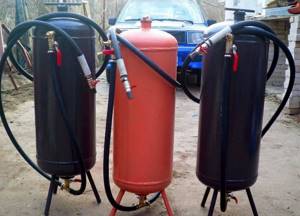
Sandblasting equipment Source kursremonta.ru
Ultrasound Applications
If a part has complex lines, it can be processed efficiently using ultrasound. Fat deposits are eliminated under the influence of waves of different frequencies, which depend on the size of the object. The larger the impact zone, the stronger the vibrations directed towards it should be.
Some types of contaminants are difficult to remove even under high frequency ultrasonic waves. In this case, it is necessary to supplement the technology with the use of organic or aqueous solutions. It is not always advisable to process large parts in this way, since this increases energy consumption.
Which nail degreaser is best?
Regarding the companies that produce the product being described, craftsmen give preference to one brand or another depending on their own taste, habits, and price category. Professional work, salon, at home, involves the use of formulations from brands that have proven themselves to be reliable. Such products are more expensive, but are used sparingly and provide the result: optimal adhesion of the nail surface to the polymer substance, prolonging the life of the manicure.
If a girl builds and strengthens her nails on her own at home, it makes sense to replace the professional product with a simpler product.
When it comes to primers, it is necessary to take into account the classification of compositions:
- acidic - aggressive, but more effective: the compositions lift the scales of the top layer of the nail, ensuring maximum fixation of the gel, gel polish;
- acid-free - gentle, does not affect the structure of the nail plate, eliminates fat and dirt.
The choice of a specific type of degreaser for manicure depends on the need for a more durable fixation of the artificial product on the nails.
Important
It is necessary to distinguish between bond and bonder. Bonder or bonder-gel is the first phase in the gel system. This is a liquid substance that is applied in a very thin layer using rubbing movements. We invite you to familiarize yourself with the Symptoms and signs of psoriasis: why does psoriasis happen and how does it manifest itself?

Primer
Primer and nail bonder are not interchangeable. Acrylics, for example, almost always require a primer, and bond will not work as an alternative. A primer (whether acidic or not) serves one main purpose: preparing the nail bed for artificial extensions. Chemically, this substance is much more aggressive towards natural nails.
Acid-free primers are slightly corrosive, but are much less harmful to the skin compared to acid primers. The latter can cause a chemical burn if they come into contact with the skin; the primer is applied only to natural nails. A primer should always be used before applying acrylic or gel (depending on the type of primer).
They prepare the natural surface of the nail for the ultimate goal - better adhesion. In this case, the degreaser (also called nail prep) removes dust and grease from the nail plate, acting superficially. A dehydrator removes excess moisture from the surface of the nail and dries it deeply. Women with excessive sweating and oily skin are advised to use a dehydrator before applying nail extensions, otherwise a degreaser will suffice.
When should you use a dehydrator?
- Before applying nail polish.
- Before applying nail gel.
- Before applying nail primer for acrylic extensions.
How to Apply Degreaser to Nails
Despite the apparent ease of use of nail plate degreaser, its use requires compliance with certain rules.
- The composition is applied to the nail plate after it has been treated with a file or buff.
- The surface of the nail must be clean.
- The liquid is applied using a lint-free cloth.
- After the procedure, you should not touch the nail with your fingers; you must avoid contact with anything.
After the surface of the nail is degreased, the first layer of coating is applied, depending on the type of manicure, it can be gel, gel polish, or base top.
Attention! When carrying out degreasing, it is impossible to replace lint-free wipes with cotton pads: particles of the fibers of the discs remain on the nails, impairing adhesion, which can lead to peeling and harm the plate.
Start of the process
Let's get started: “The devil is not as scary as he is painted.” After you have adjusted the length of your nails and their shape using a nail file and scissors, we proceed to remove cuticles and hangnails using nippers and special iron tweezers. After completing these necessary procedures, we strongly recommend applying cream to your hands and thoroughly (massage movements) rub it into the skin.
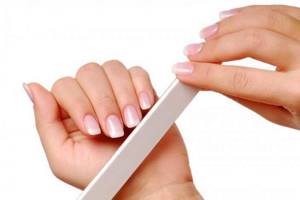
On a note! Then you can apply either a medicated varnish to your nails or an effective product that promotes nail growth and strengthening.
How can I replace degreaser for gel polish?
Although nail service experts say that replacing a degreasing liquid with anything means jeopardizing the quality of your manicure and your health, there are times when it is necessary to resort to this.
There are natural and synthetic products that can be used to replace nail degreaser at home.
Is it possible to degrease nails with boric acid?
From the products available in the home medicine cabinet, in order to replace the degreaser, use boric alcohol, which is a solution of boric acid in 70% ethyl alcohol. The product is used in medicine and is harmless when used externally in the dosages described in the instructions for the drug.
Boric acid as a nail degreaser exhibits the following properties:
- destroys microorganisms located on the nail plate;
- removes dirt;
- removes fatty film from the surface of the nail.
Nail service specialists do not recommend using the drug on an ongoing basis, although they allow one-time use of boric alcohol if necessary to replace the composition for degreasing nails.
Is it possible to degrease nails with alcohol?
Ethyl alcohol can be used at home to replace degreasing liquid. The substance effectively removes oily cosmetics (creams, oils), disinfects the surface, and removes natural fatty film.
Important! Replacing a degreaser with alcohol on an ongoing basis means drying out the nail plate and the skin around it.
Formic alcohol for degreasing nails
Formic alcohol is a colorless liquid with a pungent odor of alcohol, prepared by dissolving formic acid in 70% ethyl alcohol. The drug is used in medicine, is sold in pharmacies without a prescription, can be found in a home medicine cabinet, and is allowed to replace the professional composition.
Instead of a nail degreaser, formic alcohol is used according to the same rules as a specialized cosmetic product, applying it to a lint-free napkin.
Nail polish remover instead of degreaser
It is impossible to degrease nails with nail polish remover: a modern composition without the addition of acetone does not dry out the nail plate and is not able to remove oily substances. This composition cannot replace a special product. A cosmetic product containing acetone will do the job.
Lemon juice or citric acid
Lemon juice or citric acid diluted in water can replace a specialized composition. The advantages of natural juice are that it simultaneously whitens and vitaminizes the nail plate.
Soap solution
Nail service specialists believe that it is impossible to replace a degreasing liquid with a soap solution: it does not remove 100% of dirt and grease from the nail due to the technology of use.
Vinegar
Table vinegar eats away dirt, grease film, dries out nails and can replace a degreasing composition for nails. It is not recommended to use it often, since acetic acid dries the skin and nail plate.
Why is degreasing necessary?
Many people neglect this stage of work, resulting in an unreliable and weak coating. To understand why this happens, it is necessary to delve into the structure of substances.
Fatty areas not only contaminate the surface, but also create a special layer on it that repels liquid. This leads to difficulties in the penetration of applied substances into the material. In addition, dust adheres to the oil droplets, further aggravating the situation.
Such problems are relevant not only during gluing and painting, but also during welding. Petroleum products remaining on parts become slag during the welding process. As a result, the seams lose their strength and undergo rapid destruction. To prevent such consequences, be sure to degrease the surface.
Reviews of nail degreaser
When studying the opinions of manicurists about various products, you need to take into account that there is a moment of individual intolerance to the components, bias. The best way to form your own opinion is to test the product yourself.
Reviews of degreasing compounds from different companies are given below.
Lena, 28 years old, Penza
I use the proven Kodi Nail Fresher. The liquid has never let me down. The quality corresponds to the cost, result, and volume of the tube. Among the shortcomings, I would like to note the brush – too small, dense (but I’ve already gotten used to it); unpleasant smell. There were no detachments or problems with nails when using the degreasing composition of this company. The brand really cares about the quality of its products, this is evident from the result of the work; there was no desire to replace it with another. I recommend.
Valentina, 41 years old, Krasnodar
I do nail strengthening at home. This is my extra income. I do marigolds for myself and my girlfriends. Regarding the degreasing liquid, I admit, I had to replace it several times with regular pharmaceutical alcohol. The result was almost the same, the coating stayed on normally. Later I bought a primer in the store because I read that regular use of alcohol on nails harms the plate. But for a couple of times it turned out to be an excellent substitute, the girls are happy.
Oksana, 25 years old, Donetsk
My review of Severina degreaser. The PNB product I tried ran out, so I decided to experiment and replace it with a new one. Before buying Severina, I looked at the reviews, saw positive ones, calmed down, and bought it. Having problems with my nails and skin, I went online again and found a lot of negative feedback! The first thing I encountered was the smell. Harsh, unpleasant, corrosive to the eyes! I endured the inconvenience and covered my nails with gel polish. An hour later they started to hurt! I tried not to pay attention, and in the evening I looked at my fingers that were in contact with the degreaser and was horrified - my skin was corroded! She began to peel off. Frightened, she took off the covering. Everything is fine with the nails, but who knows what would have happened to them if it had been on longer... Than such a product, it is really better to replace it with homemade preparations, for example, boric acid. My advice – don’t be flattered by the low price and take care of your health!
Why does the shine disappear after removing the sticky layer?
Sometimes home craftsmen are surprised why the shine disappears after removing the sticky layer, but this is natural:
- If the coating is poorly dried. It may appear to be completely polymerized, but this is not always the case. An old and low-power lamp is not able to properly dry top coat or gel polish. This is manifested not only by the disappearance of gloss, but also by worse durability of the coating in the future. Incomplete polymerization is possible due to too thick layers of gel polish, base, or top coat.
- If the products used for manicure are of poor quality. Most often, this is the case with cheap gel polishes and top coats or counterfeits of well-known brands. They also have a sharper and more unpleasant odor and chip off the nails faster.
- If the cleaner is not suitable for a particular brand of gel polish or finish. Some of the auxiliary fluids are too aggressive and contain acetone. And along with the residual stickiness, the next microlayer of the coating is removed, giving it gloss.
- If you were in a hurry to remove the dispersion layer. Experienced craftsmen recommend taking a break for a couple of minutes after polymerizing the coating for a reason. It should cool down. This doesn't mean your nails will be hot all the time. But you need to wait precisely so that the gloss “settles” on the surface and cannot be removed.
- If a matte finish was mistakenly used instead of a shiny finish. Some products in this series remain shiny after polymerization. And only rubbing with a clinser gives them real texture.
- If you used one napkin at all stages. This saving leads to the fact that after wiping the dried base product, particles of the removed layer remain on it. After processing polymerized gel polish, the amount of debris increases. It turns out that nails with a finishing coat are wiped with a completely dirty napkin, and the sticky layer is simply smeared over their surfaces. Don't be surprised that the top becomes cloudy and loses its shine.
- If instead of a clinser you took a handy alcohol-containing product. Perhaps it is incompatible with a particular brand of top, which is why the coating fades.
You can avoid the problem if:
- paint your nails with high-quality materials;
- at least use a professional product for the finish and not a substitute;
- make sure the base, gel polish, top and cleanser are compatible;
- do not rush to get rid of the dispersion layer immediately after polymerization;
- use a different napkin for each nail and change it for a fresh one at all stages.
Alcohol
It is very important to replace the degreaser with alcohol. It effectively copes with the task, and will also act as an antiseptic.
It is better to use alcohol above 75%, for example:
The main thing is not to use methyl alcohol, and not to overdo it with the procedure. In addition to pure alcohol from the pharmacy, you can use products based on it.
- formic acid;
- boric alcohol;
- injection wipes;
- hand sanitizer.
The wipes are impregnated with alcohol and made of non-woven material that does not leave lint on the surface. Antiseptics must contain alcohol, otherwise they will not cope with the task.
Also, you can’t ignore triple cologne - it effectively removes any dirt from your nails.
Degreasing metal
In addition to grease and dirt, metal often contains rust, paint, and sealant residues. For metal processing you should choose white spirit, acetone, gasoline.
The procedure is as follows:
- Remove rust, paint, sealing residues with a grinder, manually, grinder, sandpaper - in any convenient way (the bathtub in the house is treated with a sponge and soda). It is better to clean large areas with a power tool.
- Moisten a cloth with solvent and treat the product until completely clean. If the parts are small, you can simply immerse them in solvent.
- After complete drying, you can apply primers and paints. Those areas that cannot be painted should be covered with double-sided tape.
Tips from manicurists that you shouldn’t forget
Advice from manicurists will help you choose and use the right degreaser or any product instead:
- Do not use cotton pads or cotton wool to apply nail degreaser. They will leave small fibers on the surface, which will lead to poor-quality coating. Use special lint-free napkins or rags made of linen or cotton. An ideal option and alternative to a degreaser would be alcohol wipes for injection from a pharmacy. Soft brushes with pony bristles or sponges can be used for this purpose.
- Immediately before a manicure, or better yet, do not use hand creams or lotions throughout the day. The fat from the absorbed cream cannot be removed by any means; it is quite capable of leading to poor-quality adhesion and will reduce the wear resistance of the gel or shellac. Avoiding cream before coating will help achieve a smooth, even color.
- Before using the degreasing composition, treat the nail plate with a special soft file. This will remove the top thin layer, exfoliate the surface and improve adhesion.
- Apply surface grease remover immediately before applying the first coat of base coat or gel. If a lot of time has passed (more than 60 minutes) after applying the product, duplicate the layer.
- After applying the product, do not touch the nail plate with your fingers or palms, this will disrupt the achieved effect.
Be sure to follow these tips and your manicure will be high-quality and long-lasting.
We have looked at all possible options for replacing degreaser for gel polish, and now pay attention to the reviews of girls who used one or another replacement option.

